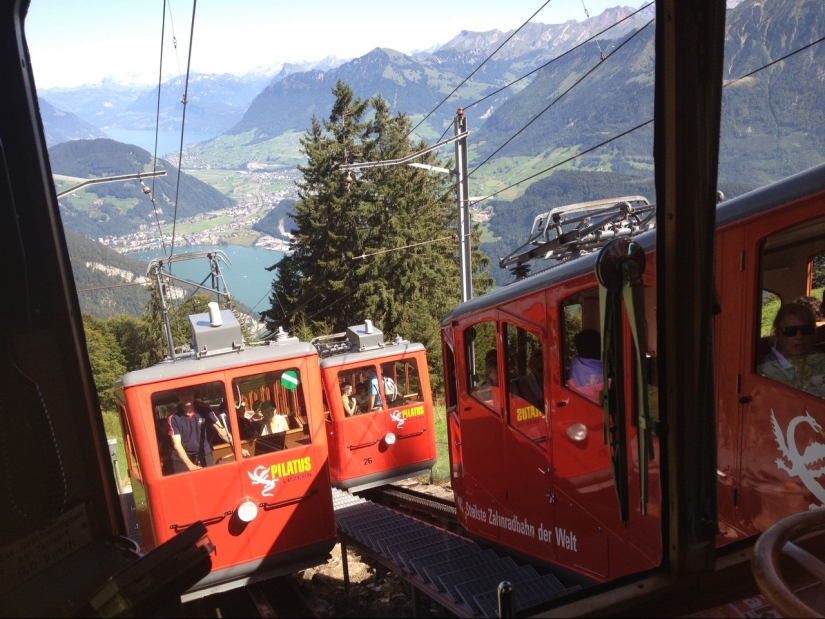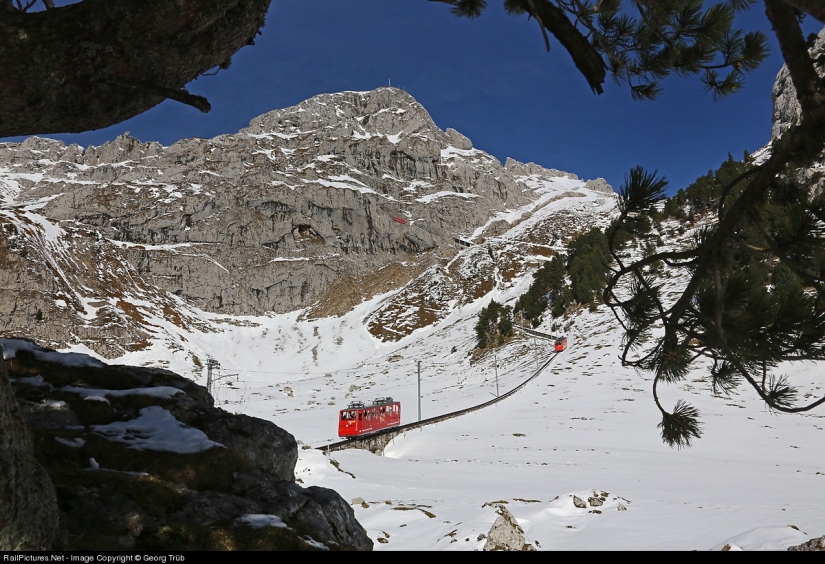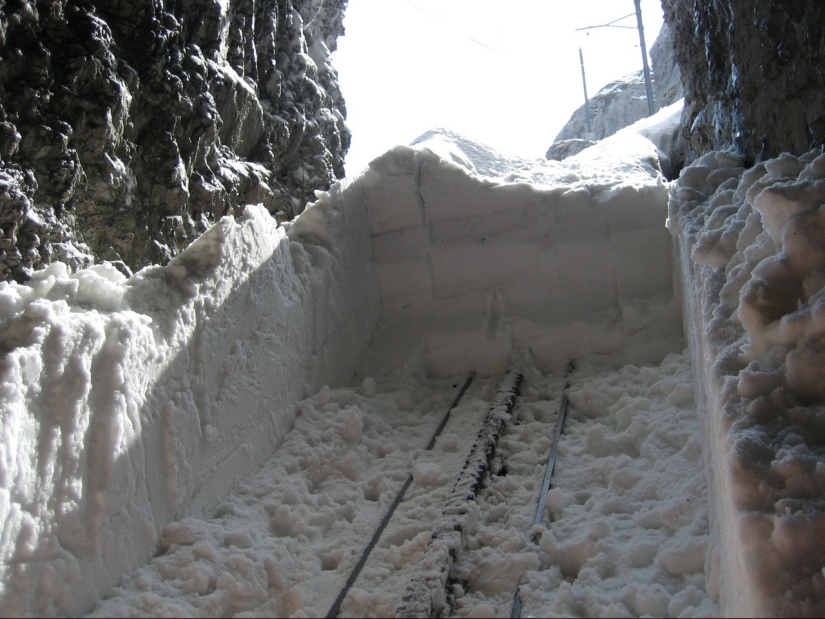Pilatusban — the steepest railway in the world
Pilatusban is considered the steepest railway in the world. The entire route from the town of Alpnachstadt to the top of Mount Pilatus takes the train half an hour, making a couple of stops along the way. The most dangerous section of the Pilatusban railway is at the end, when the train enters the tunnels, and tourists convulsively squeeze into chairs.
This is where the real Swiss extreme begins.


Pilatus is a mountain range in the Swiss Alps, one of those places where "you need to visit". There are three ways to get to the top of the mountain: by cog railway (from Alpnachstad), by cable car (from Kriens) or on foot. Any of the climbing methods will leave an unforgettable impression, the main thing is to guess with the weather. And it is changeable here — rain can change sunny weather without warning, and vice versa. And this is sometimes several times a day.

Pilatusban is an old railway, its opening took place in 1889, and in 1937 it was electrified.

The construction of the railway was carried out according to the project of an engineer with a speaking surname, Eduard Locher. An interesting fact is that when he proposed a design with two horizontally moving gears, he was called an oddball. Today, the Locher system is one of the most common designs of gears on railways.

For reference: a gear railway is a rail type of transport whose motor cars (or locomotive) are equipped with one or more gear wheels. They turn on while driving. A gear rack is laid between the ordinary rails, with which the gear wheel of the locomotive (or wagons) is coupled. This technology provides better traction with rails when climbing on slopes up to 16% or more (for dry conditions) and up to 14% (for wet conditions).

Currently, there are more than 150 gear railways in the world. Continuously operated (winter and summer) — about 60 roads. Switzerland accounts for 50% of all operating roads.

This country has the longest experience of operating such roads, the most modern rolling stock of its own production and the steepest roads (28% and 48% slope). In addition, Swiss roads are mostly profitable and cost-effective.

Austria, Germany, Hungary and a number of Latin American countries (Brazil, Venezuela, Chile) can also boast of jagged roads.

They are used as a way to travel along tourist routes in mountainous areas or as urban passenger transport (for example, in Budapest, Zurich or Stuttgart). There are no toothed railways on the territory of Russia.

10 cars with a capacity of 40 people each run along the Pilatusban route. The maximum capacity of the road is 340 people per hour. The average speed is 9-12 km/h.

Inside the cars there is cleanliness and an interior in the style of the 50s of the last century. The manual power windows and the inscription "Do not lean out of the windows" immediately catch your eye. This is important — there are sections of the road where, by stretching your hand out of the window, you can pick mountain flowers or touch a rock.

You need to sit in the car facing the top of the Pilatus. On the left side there are landscapes of mountains, rocks, meadows, forests, and on the right side a stunning view of lakes and settlements is added to them.

Well, all around, as well as throughout Switzerland, you can hear the ringing of bells of grazing cows. Those who are interested in the process of controlling the train can sit in the first car and watch the work of the driver.

30 minutes on the way fly by in a flash. The train makes short stops along the route.

One of them, at the Amsigen station, lasts a couple of minutes — here you can buy cheese from farmers. But not as in In Russia — from the window of the train or on the platform, and go into the house, taste the cheese. Only the taster train is not waiting for them, they will have to get on the next scheduled train.

The final segment of the route is the most exciting — it is a passage through tunnels hollowed out in the rocks, these are the same slopes of 48%, these are cliffs tens of meters high in a meter from the train.

The question immediately arises in my head: "How long will we fly if the brakes fail?" Joke! Thoughts about something else — not to drop the camera and not to break your neck at the entrance to the next tunnel. The only negative from a trip on the road, which, however, you do not pay attention to, is the noise of gears.

At the top of Pilatus Kulm Mountain, there are a lot of things — hotels, restaurants, cafes, souvenir shops, outdoor and indoor viewing platforms and five hiking trails with a height difference of up to 60 m.

What to do: look at the scenery outside the window and click the camera shutter during a train ride on the Pilatusban railway.How to get there: Alpnachstadt is located at the foot of Pilatus Mountain. You can get to Alpnachstadt by train from Lucerne (about 30 minutes) or by ferry from pier No. 2 (1 hour).Equipment: despite the temptation to reach out and pluck an Alpine flower, you can not lean out of the window.

Infrastructure: the train consists of 10 trailers.How to improve the experience: get off at one of the intermediate stops and buy cheese from local farmers. However, then you will have to stay and take the next train.Entrance fee: 68 Swiss francs.

Opening hours: from 8:10 to 17:50. The last train leaves at 18:45.Where to spend the night: in the city of Lucerne or in a hotel on the top of Pilatus Mountain.What to bring as a keepsake: cheese from local farmers, lots of photos and impressions.
Recent articles

There are many places in the world where only the chosen ones can be. The cities of Mecca and Medina in Saudi Arabia are well known ...

This collection of photos will clearly please the little inner perfectionist who lives in each of us. It doesn't matter how much ...

If you don't feel good about the donut you ate for lunch, relax - it can get worse ... At least you didn't eat the ...